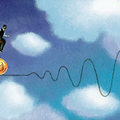Economic uncertainties abroad, and now at home
| |
 | |
SINCE the toxic fallout from America’s subprime mess began to taint Japan’s own financial markets last month, it was possible to argue that if Japan was a victim, then at least it was a blameless one. Now, poor economic data at home have generated concerns about the country’s own economy. For the Bank of Japan, the past weeks come as something of a shock: anticipating a robust economy, it had planned to raise interest rates this summer on a path to “normalise” rates that had been set at zero until last year and that now stand at a mere 0.5%. Global credit-market turmoil, and now concerns about a slowing economy at home, have given the central bank no choice but to tear up its road map.
There seemed a measure of injustice to how Japan’s publicly traded financial markets were hit by credit troubles in the United States and Europe. Japanese financial institutions are bit-part actors in the subprime drama. Marked still by the bursting of Japan’s own credit bubble in 1990, companies and households have an aversion to borrowing. The amount of all corporate bonds outstanding in Japan, measured as a percentage of GDP, is close to the amount of subprime and other high-risk debt alone in the United States. Individuals’ aversion to risk is seen in an unnaturally high proportion of household wealth kept as cash or near-kin. As for the kind of financial innovation that had allowed risky debt in the United States to be cut, sliced and sold throughout the financial system as high-class fare: it has passed Tokyo’s sleepy markets by.
No matter: at the height of the August panic, the Nikkei 225 index had fallen by 16% from its July peak, and by 9% in a single week. Today, losses for the year are near 8%, and the once-safe shares of Japanese REITs—real-estate investment trusts—have taken a particular hammering. Shares in America, the source of the credit crisis, are still higher than at the beginning of the year—despite atrocious jobs figures for August released on September 7th that have raised the spectre of an American recession.
The convenient explanation until now for Japan’s stockmarket falls was that Western banks, hedge funds and others hit by worries about liquidity and demands from investors for their money back got rid of whatever was easiest to sell. That included the easily traded shares of Japan’s biggest companies. It also helps to explain a surge in Japan’s currency as higher volatility led many hedge funds to unwind their once-profitable positions in the carry trade, where people borrow cheap yen in order to invest in high-yielding currencies—the New Zealand dollar, for example.
Then came some dismal scraps of domestic economic news. The first, last week, was that capital spending, which has done most to haul Japan out of its long slump and underpin a steady if unspectacular recovery, had taken a hit. That led economists to expect a downward revision to GDP figures for the April-June period, but the scale of the revision on Monday September 10th still managed to shock: instead of growing by 0.5% compared with a year earlier, the government now says the economy shrank by 1.2%. Shares slumped on the news, with some analysts arguing that Japan is now in a bear market.
This may be overdoing things. For a start, Japan’s data is notoriously volatile: as if to prove the point, figures released on September 11th for machinery orders in July recorded a huge bounce. What is more, Japan has hit soft patches before in its five-year-old recovery. And while households have still not opened their wallets despite the predictions of so many economists, companies continue to make record profits. Indeed, on September 10th Nomura Securities, the largest brokerage, upgraded its profit forecasts for Japan’s biggest companies this financial year. If economists now argue that the risks to Japan’s economy are rising, most are far from predicting a full-blown recession—even if America tips into one.
Still, it leaves the Bank of Japan on the twin horns of growing problems in America and a softer economy at home—in addition, core consumer prices have fallen slightly for five months in a row. The central bank’s case for raising rates is that low rates risk unwelcome bubbles forming in various asset markets, while it feels almost a moral repugnance at the notion that cheap money rewards abysmal businesses more than well-run ones. The Bank of Japan looked all but certain to raise rates by a quarter-point in August, until the credit woes. Now a rate hike at the bank’s policy-board meeting next week also looks out of the question, while even a rise later this year is in doubt. The path to normalisation, the Bank of Japan is finding, is a long and tortuous one.





